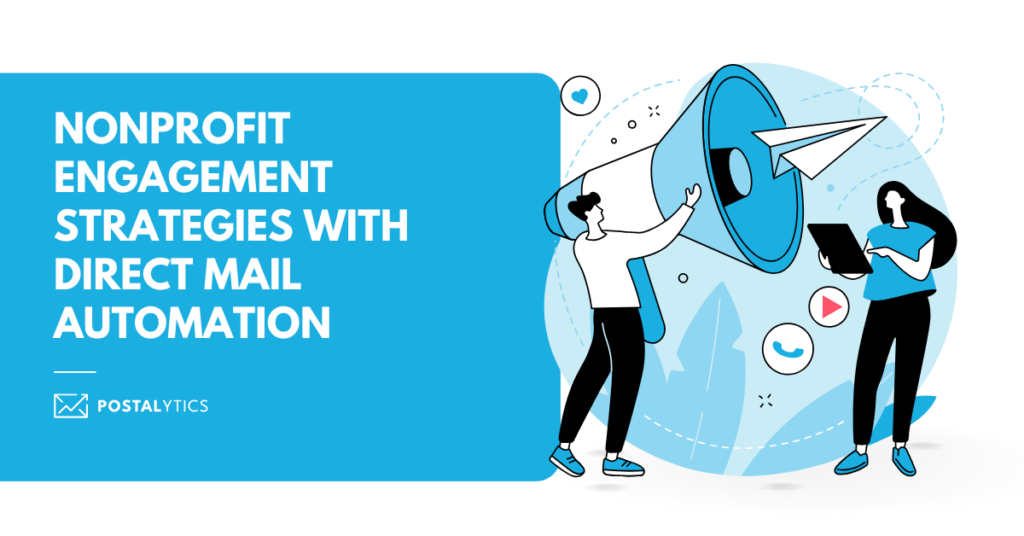
For nonprofit organizations, the challenge is twofold – vying for donations and building long-lasting relationships with your community.
But when dealing with constrained budgets and resources, you need effective strategies.
One such strategy is direct mail automation.
As a direct mail automation platform serving nonprofits, we’ve seen the benefits of automating direct mail. We’ve created a one-stop guide to help you implement direct mail automation.
Let’s get started.
What is Direct Mail Automation for Nonprofits
Direct mail automation uses technology to simplify creating, sending, and tracking direct mail marketing campaigns.
For nonprofits, it offers the proven effectiveness of traditional direct mail with the efficiency and accuracy of modern automation tools.

Nonprofits can use direct mail automation to send personalized donation requests to past donors. The software can then;
- Pull data from their CRM,
- Segment donors based on previous giving history,
- Tailor the message to highlight specific projects or offer event invitations.
Direct mail automation also allows tracking the delivery of each piece and analyzing response rates.
Read more: What is direct mail automation?
Benefits of Direct Mail Automation for Nonprofits?
Direct mail automation for nonprofits can be used for a number of tasks.
Here are four quick reasons why you need to adopt it today.

1. Cost-effectiveness
Automation reduces labor costs by minimizing manual tasks like data entry, printing, and mailing. This frees up staff to focus on strategic activities, optimizing resource use.
For example, a nonprofit could automate a donor campaign. Doing so would allow staff to spend more time on direct mail fundraising strategy than administrative tasks.
2. Speed and Scalability
Direct mail automation enables nonprofits to scale efforts without increasing workload. Speed and scale are crucial for reaching more people and boosting donations when needed.
For example, disaster relief nonprofits need to ensure timely support and maximum impact. With direct mail automation, they can launch large-scale fundraising campaigns quickly in response to an emergency.
3. Better Tracking and Reporting
Automation tools offer real-time tracking of campaign performance metrics, like response rates, conversion rates, and ROI. With detailed analytics, nonprofits can make informed decisions and refine strategies.
For example, a nonprofit could analyze a fundraising campaign’s success once completed. Using the insights gained, they could adjust future mailings for higher engagement.
4. Increased Response Rates
Increased response rates are a major benefit of automated direct mail. By sending personalized communications, nonprofits boost the likelihood of donor response and participation.
Well-timed, meaningful messages enhance the donor experience, fostering ongoing support.
For example, we’ve seen nonprofits send donors personalized thank-you notes and project updates. These mails result in higher engagement and increased repeat donations.
How to Set Up a Direct Mail Campaign for Nonprofits?
If you’ve been taking a random approach to nonprofit direct mail marketing, we’re here to put a stop to that.
We’ve compiled a step-by-step process to ensure your direct mail campaigns are successful.
1. Define Goals
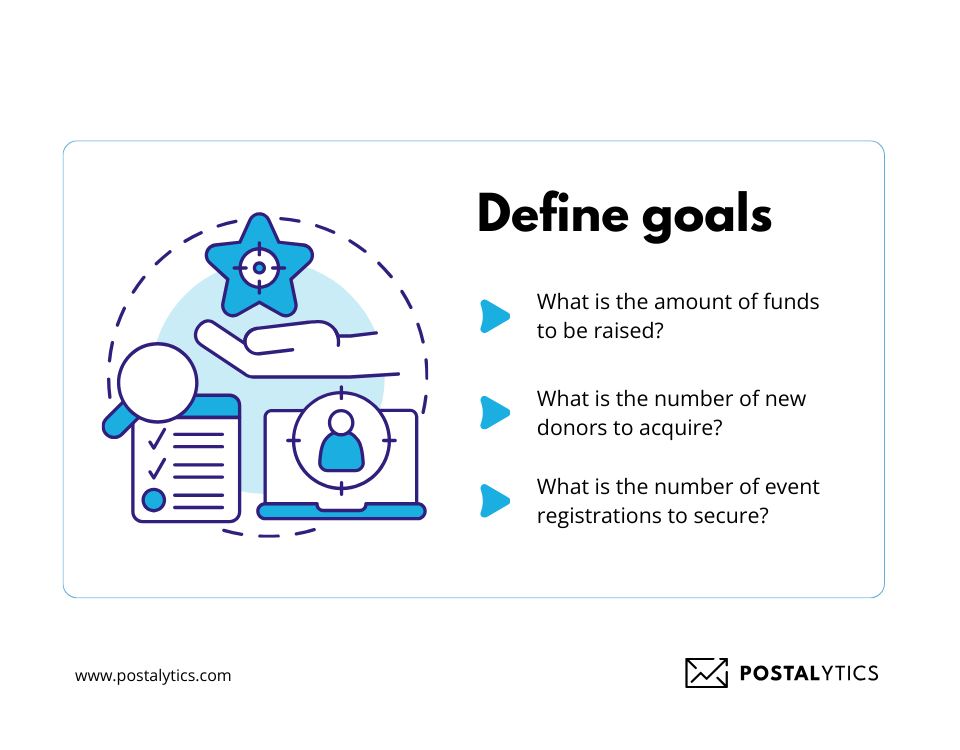
Defining the goals is the first step in setting up a direct mail campaign for nonprofits. Having a fixed goal helps marketers establish a clear direction and set the stage for later steps.
Marketers should set specific, measurable targets. For example;
- What is the amount of funds to be raised?
- What is the number of new donors to acquire?
- What is the number of event registrations to secure?
With goals in place, you can tailor your strategy, allocate resources, and evaluate the campaign’s success.
2. Identify and Segment Your Audience
Marketers can use their CRM to analyze donor data, identifying key segments based on donation history, demographics, interests, and past interactions.
This means that nonprofits can send tailored messages to specific groups within their audience. These segmented groups could look like this;
- Long-term donors might receive a detailed update on the impact of their contributions,
- Recent donors could get a personalized thank-you note with an invitation to a special event,
- Potential donors might receive an introduction to the nonprofit’s mission and success stories.
3. Set Up Automation Workflows
Automated triggered mailings are when specific actions or events initiate the sending of personalized mail pieces. This automation removes manual intervention and ensures the messages are sent to the right people at the right time.
For example, say a donor makes their first contribution. An automated workflow can trigger a thank-you letter and a welcome packet detailing the nonprofit’s mission and impact. If the donor continues to donate, additional automated triggers can send updates on how their donations are making a difference.
This systematic approach keeps donors engaged, enhancing their experience with the organization.
4. Craft Your Message
Your message should be crystal clear so your recipients act on your CTAs. Marketers must create personalized and compelling messages that resonate with each audience segment.
Highlighting the impact of donations can emotionally engage recipients and inspire action. For example, a nonprofit could share personal stories of people impacted by donations.
When designing, use eye-catching visuals, concise copy that conveys the organization’s mission and urgency, and well-placed CTAs for easy identification.
5. Plan and Schedule Your Campaign
Choosing the right timeline is crucial for success. It determines when recipients will receive your messages and how they align with campaign objectives and audience behavior. Optimal mailing dates may coincide with holidays, seasonal trends, or fiscal year-end. These are periods where you can maximize engagement and response rates.
Marketers can leverage direct mail automation tools to schedule mailings ahead of time. By planning and scheduling each step of the campaign, nonprofits can reach their audience, maximize impact, and achieve their fundraising and communication goals.
6. Analyze and Report

This is the final step in setting up a direct mail campaign for nonprofits. Nonprofits need to track and analyze their campaigns to optimize future efforts. Using unique identifiers like QR codes, PURLs, or campaign-specific phone numbers enables accurate tracking of responses.
You should evaluate KPIs such as response rates, conversion rates, and return on investment (ROI). By analyzing these metrics, nonprofits can identify what worked well. It also points to areas for improvement, informing future strategies.
This also allows nonprofits to demonstrate impact to stakeholders and make data-driven decisions.
5 Powerful Direct Mail Engagement Strategies for Nonprofits
Every nonprofit wants to better connect with its audience and improve engagement.
Here are five strategies nonprofits must try.
1. Use Mission-Driven Storytelling
Mission-driven narratives deepen donor engagement, foster connections, and drive support for their cause.
Mission-driven storytelling in direct mail involves crafting narratives that emotionally resonate with recipients. Start by introducing the nonprofit’s mission and the problem it aims to address. Then, share compelling stories of individuals or communities benefiting from the nonprofit’s work. Use vivid language, testimonials, and concrete examples to evoke empathy and inspire action.
Here’s an example by Native American Emergency Relief.
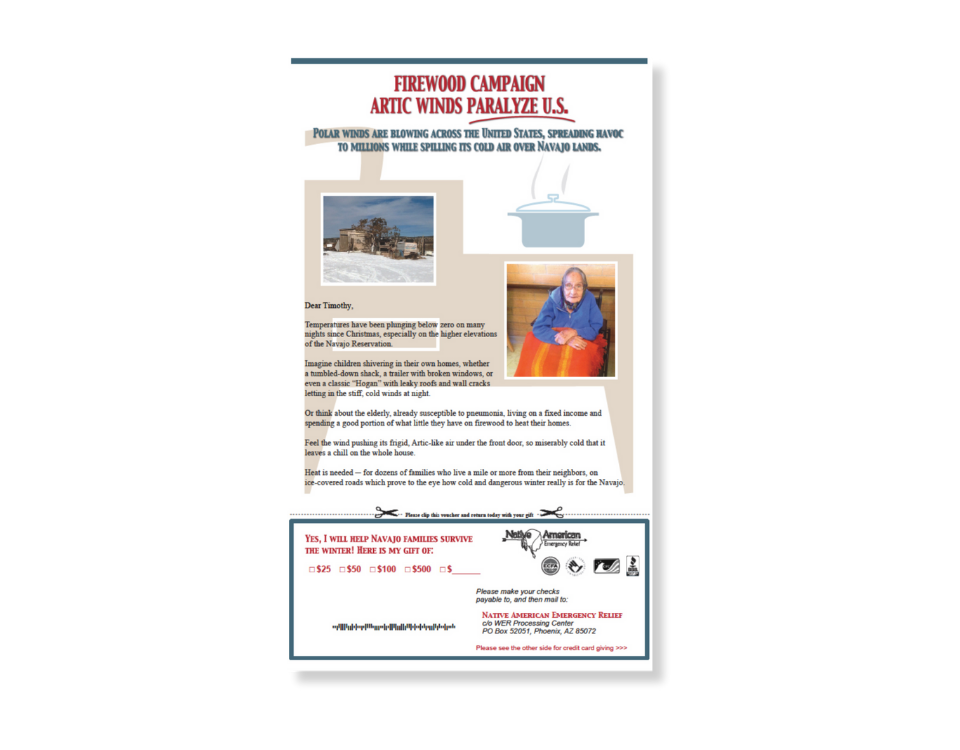
2. Show What You Are Accomplishing With Donations
Everyone likes donating to a good cause. However, nonprofits often fail to inform their donors where/how they use the donated money. By showing this through visuals or powerful testimonials, you can reinforce their decision to donate.
Many organizations use a before-and-after approach. It’s effective at showing the reality of what took place. For example, say your nonprofit works to improve the lives of the underprivileged. In your direct mail, you could show how the funds provide better facilities, education, or homes.
Here’s a good example of powerful testimonials.
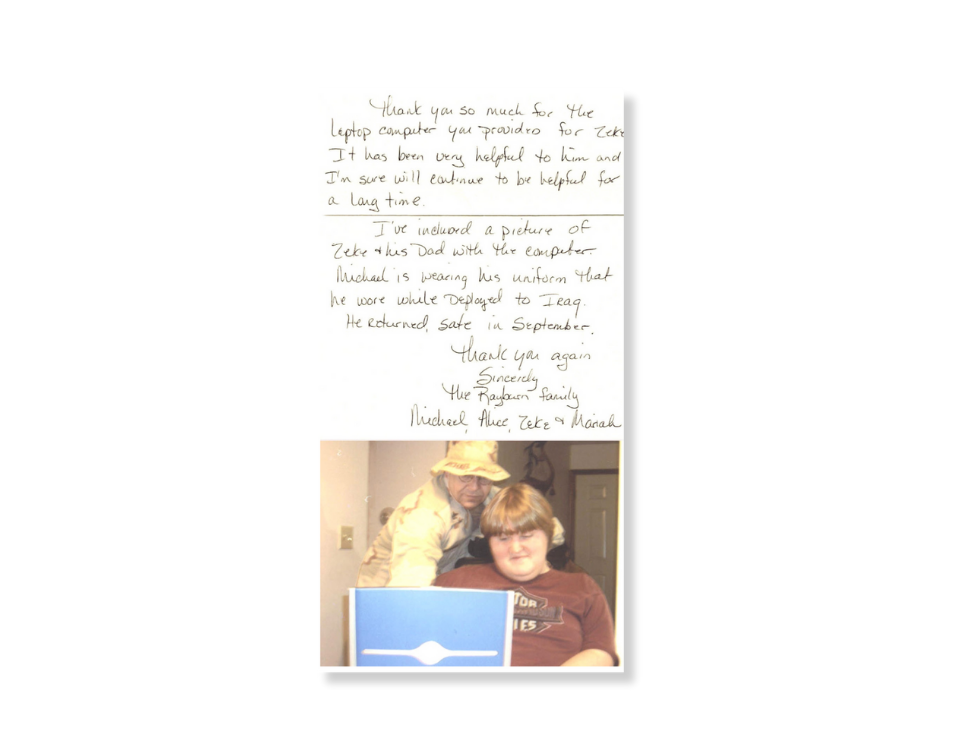
3. Keep Nurturing Donors
Nurturing donors in nonprofit direct mail fosters long-term relationships. Regular communication acknowledges donors’ contributions, updates them on the organization’s impact, and reinforces their connection to the cause.
By staying engaged, donors feel valued and appreciated. We know first-hand that this increases the likelihood of continued involvement and future giving. Nurturing keeps the organization top-of-mind so donors remember who to support upcoming campaigns or initiatives.
Ongoing engagement builds trust and loyalty. It can turn one-time contributors into loyal advocates who champion the nonprofit’s mission to others.
4. Include Value-Added Content for Donors
Including value-added content for donors in nonprofit direct mail enhances engagement and appreciation. It provides donors with meaningful information and improves their connection with the organization’s mission.
This content can take various forms, like informative inserts, impact resorts, program updates, and newsletters. Make sure that this content goes beyond soliciting donations. Instead, it should aim to educate, inspire, and connect donors to the cause.
For example, you could share facts on why the cause is important and how the world will look without people working towards it.
5. Use Integrated Channel Campaigns
Nonprofits should use multiple communication platforms to deliver a cohesive message.
Start by crafting a unified message and consistent branding across all channels. It must be cohesive, whether it’s direct mail, email, social media, or your website. It’s also key to synchronize the timing of messages to reinforce your campaign. This strategy creates touchpoints that guide supporters through the donor journey.
For example, say you’re a nonprofit launching a fundraising campaign for building a new community center. You could send direct mail with compelling stories and a donation appeal. Then, you could follow up with personalized emails linking to a donation page. Finally, you could use social media to share progress updates and engage followers.
Case Study: How Homestart used affordable non-profit direct mail to drive donations and event registrations
Homestart is a nonprofit aiding homelessness in Greater Boston. They wanted to improve email marketing performance by complementing it with direct mail. So, they used Postalytics to automate direct mail campaigns. They simplified participation by integrating QR codes on postcards. These QR codes directed recipients to online registration and donation pages.
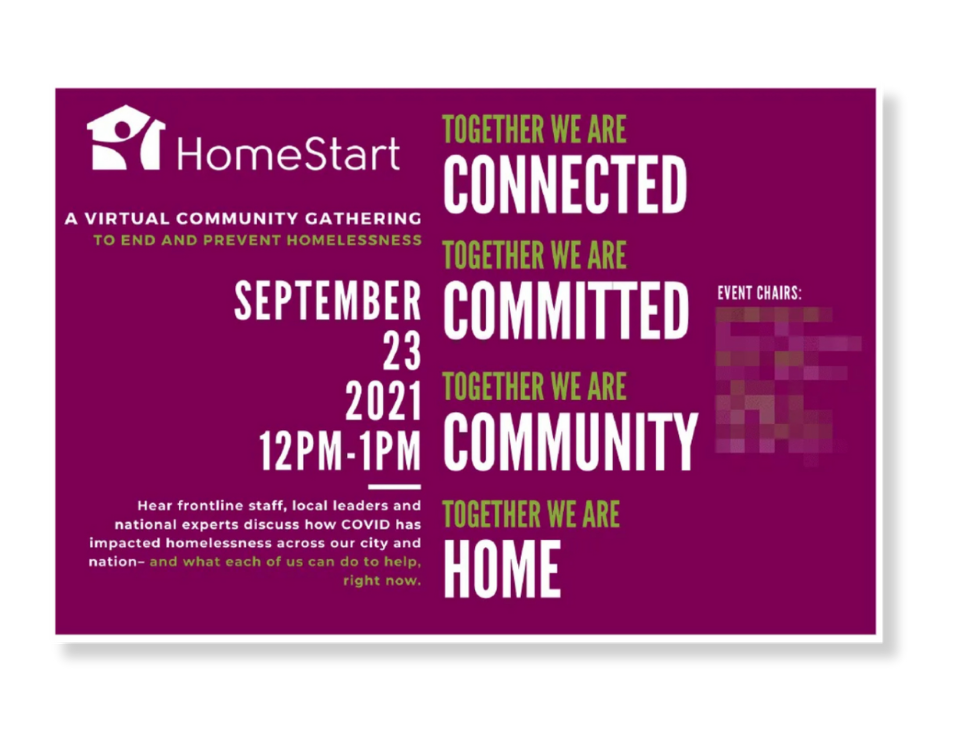
Using physical mail to complement digital efforts ensured consistent donor communication. The ease of creating and executing mail campaigns allowed Homestart to focus on its mission while still reaching donors. This approach was particularly beneficial during COVID-19, enabling rapid response to increased needs.
As Homestart put it –
“I’ve done events before, and the direct mail part is stressful, but the Postalytics mailings were easy. A few days after we did the design and uploaded the mailing list, people had the postcards and were telling me how good they looked.”
Supercharge Non-Profit Direct Marketing With Postalytics
Direct mail is one of the most effective marketing channels for nonprofits. It blends personalization, strategic planning, and integrated communications to deliver a winning formula.
And with the strategies discussed here, you can supercharge your direct mail efforts. By defining clear goals, identifying and segmenting the audience, crafting compelling messages, and utilizing automation workflows, nonprofits can enhance their outreach and engagement. If you need a direct mail automation tool to boost your campaigns, register for a free account on Postalytics.
About the Author

David Hazeltine
David is a career, award-winning marketing, communications, and copywriting professional who joined the Postalytics team in September 2023. He has spent the past 12 years working in demand generation and events for technology & SaaS companies, including Fiserv (FinTech), Pointillist (MarTech), Blackbaud (NonprofitTech), and most recently Cisco Systems (DigitalCommsTech). Prior to joining the tech world, David spent 26 years on the agency side, the majority of which were spent in direct mail and direct response. He ran direct mail production for two agencies prior to forming his own full-service full-service agencies, which provided strategy, creative, list, print/mail production, and analysis services for both for-profit and nonprofit clients. Additionally, David is an accomplished fundraising consultant, speaker, and conference presenter. Born and raised in the Boston area, he and his wife migrated south in 2018 to their current home in Charleston, SC. They have three grown children and a German Shepherd named Zeus.
